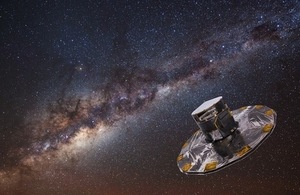Gaia
The mission to map the Universe.

Artist's impression of the Gaia spacecraft. Credit: ESA.
Launched in 2013, Gaia’s mission is to create the most accurate 3D map of the Universe to date.
Gaia orbits the Sun, at a distance of 1.5 million km beyond Earth’s orbit, offering a clear view of the cosmos beyond.
You can see an animation of how Gaia works from ESA.
The third full dataset from Gaia was released in June 2022.
How does Gaia ‘see’ the Universe?
Gaia has two optical telescopes that work with three science instruments, it repeatedly scans the sky to precisely determine the location of stars and their velocity.
During its five-year mission, the spacecraft spins once every six hours, sweeping the two telescopes across the entire celestial sphere. As the detectors repeatedly measure the position of each celestial object, they will detect any changes in the object’s motion through space.
UK leading the way on Gaia’s images
The UK has major roles in the Gaia mission, both in building the spacecraft and delivering the science. UK industry won some 80 million euros of industrial contracts to build Gaia.
UK activities now centre around the data processing for the Gaia mission. These commitments are primarily in three areas: the photometric reductions, calibrating observed fluxes in broad band and low-dispersion spectra, where the developments are primarily carried out in Cambridge, and the implementation is in Cambridge; the pre-processing of the image data, where the development is done in Edinburgh and Leicester and the implementation at DPCB (Barcelona) and the processing of the data from the Radial Velocity Spectrometer, for which software developments and validation is done at Mullard Space Science Laboratory of University College London (MSSL), and implementation is at CNES (Toulouse).
Gaia will provide a huge census of the stars and the Cambridge Gaia Data Processing Centre will be the front line in processing Gaia’s images, which will play an important role in the discovery of many thousands of transient stars and supernovae: these will be made immediately available to schools and the public for their participation in the research.
UK participation in the mission is funded by the UK Space Agency and scientists and engineers from around the UK have played key roles in the design and build of Gaia.
The UK Science and Technology Facilities Council (STFC) funded the early development of the project, including the set-up of the data applications centre. STFC’s current support involves the UK exploitation of the scientific data to be yielded from the mission.
Timeline
- Launch date: 19 December 2013
- Data Release Milestone 1: 14 September 2016
- Data Release Milestone 2: 25 April 2018
- Data Release Milestone 3: Due in two stages early partial release on 3 December 2020, final full release June 2022
- Data Release Milestone 4: Expected after 2025
- Data Release Milestone 5: Final data release provisionally planned for 2030
What have we learnt?
Gaia sent back its first test images in 2014 and sent back pictures showing a dense cluster of stars in the Large Magellanic Cloud, a satellite galaxy of our Milky Way. Read more here.
The first data release was in September 2016 and the second in 2018 lead to a revolution in how we understand the Milky Way. Read more here.
Watch a visual representation of the comparison of images from the two data releases, 1 and 2.
Early data release 3 (EDR3) will be a new public release of Gaia data, the first part of its third release, based on the 34 months of mission data. It will cover astrometric data (positions, proper motions, parallaxes) and photometric data (magnitudes, colours) for around 1.8 billion stars.
Additional Info
Updates to this page
-
Dates for data set releases and milestones amended. Link added for June 2022 dataset.
-
First published.